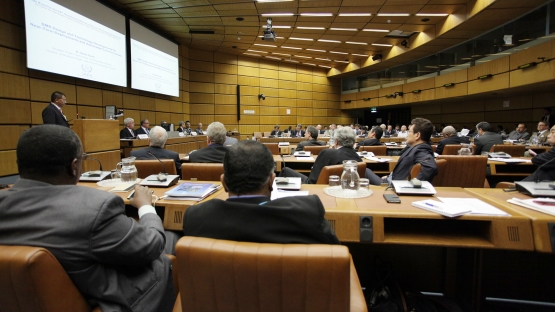Small Modular Reactor (SMR) designs and technologies that are under development in many Member States offer an option for enhancing security of energy supply in both expanding and embarking countries, an IAEA meeting heard today.
A side event to the 59th IAEA General Conference highlighted design, safety, regulation and operational aspects of current SMR designs for near-term deployment.
“SMRs can offer important advantages for nuclear newcomer countries, particularly those with small electric grids, with less-developed infrastructure and limited investment capabilities,” said Mikhail Chudakov, IAEA Deputy Director General and Head of the Department of Nuclear Energy, speaking at the event. “Countries with existing nuclear power programmes may also consider SMRs for specialized applications such as deployment in remote areas, process heat and desalination.”
Intended to produce electric power up to 300 MW (e) per unit, or around half of a traditional reactor, SMRs major components can be manufactured in a factory setting and transported to sites for ease of construction.
There are about 45 SMR designs under development around the world, half of them under preparation for deployment over the next ten years. The first three SMRs with advanced technologies are expected to become operational over the next four years: KLT-40S in Russia, HTR-PM in China, and CAREM in Argentina.
At the event, the IAEA presented its work on developing a technology roadmap for SMR deployment, to provide Member States with generic pathways. IAEA speakers also provided updates on activities regarding technical features and issues, infrastructure, safety, licensing, and regulatory oversight for SMR deployment.
Several countries new to nuclear power are considering SMRs not only for electricity generation but also for other uses such as district heating, desalination and hydrogen production, said Hadid Subki of the Nuclear Power Technology Development Section. “Embarking countries, including Saudi Arabia and Indonesia, have even initiated a pre-project engineering of SMR for cogeneration.”
Stewart Magruder of the Regulatory Activities Section of the IAEA told the audience that an SMR Regulators Forum has been established to identify, understand and address key regulatory challenges that may emerge in the future.
Representatives from Argentina and Saudi Arabia presented technology development, construction progress and deployment issues of SMRs in their countries.
Osvaldo Calzetta Larrieu of the Argentinian National Atomic Energy Commission reminded the participants of a 2006 Presidential decree declaring that the construction and startup of the CAREM prototype was of national interest to Argentina. “The construction of CAREM, the first natural circulation integral pressurized water reactor, is on schedule with first criticality aimed by 2018.”
Maher Odan from the King Abdullah City for Atomic and Renewable Energy (K.A.CARE) said he believed that the SMR market had a very large potential not only in Saudi Arabia but also in the wider Middle East and North Africa regions. “Earlier this month, K.A.CARE signed a pre-project engineering agreement with the Korea Atomic Energy Research Institute (KAERI) to deploy the Korean SMART SMR design in Saudi Arabia,” he added.
The IAEA regularly organizes technical meetings, workshops and dialogue forums to assist its Member States in SMR technology deployment by reviewing newcomer countries’ requirements including regulatory infrastructure, and defining performance indicators for operation.


